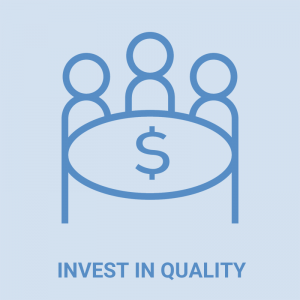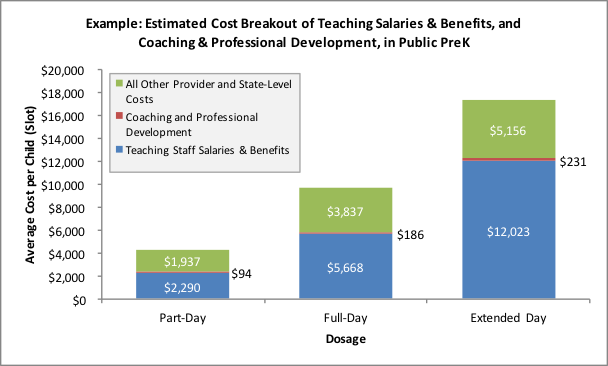High-quality pre-k is one of the best investments we can make with public dollars.

To be beneficial, early learning opportunities must be intentional, caring, and address the needs of each child. Providing such opportunities requires small class sizes and well-trained, experienced teachers. That is why much of the investment in pre-K is dedicated to salaries and benefits, along with sustainable funding to enroll as many children as possible.
Expanding access for more children means adding classrooms, and each classroom usually requires at least two teachers, plus support staff to ensure high-quality programming. Maximum class size restrictions may also require new, additional classrooms to be created. In addition to supporting existing pre-K classrooms a state must identify adequate resources to ensure access to high-quality early education for all families interested in participating.
If pre-K classes operate longer than the elementary school day–and many do start earlier and end later–additional teachers may be necessary. To provide children with an engaging and educational experience, pre-K teachers and assistant teachers need ongoing professional development. Coaching is one of the most effective strategies to ensure high-quality teaching.
The coaching model can vary widely based on the number of classrooms assigned to each coach (caseload). Annual, ongoing professional development support requires the cost associated with the training as well as any substitute teacher costs to cover the classrooms in the teachers’ absence.
Suggested Talking Points about the costs of pre-K
- Too many US children fall behind before they even start school. Good early childhood care and education can address this problem, but only if it truly is high quality. Most programs today are not high quality.
- Quality requires well-trained teachers using proven curricula to engage children in interactions that stimulate learning while being emotionally nurturing, and fostering engagement in and enjoyment of learning. Teaching is enhanced by systematic, sustained, in-classroom coaching and mentoring.
- When government supports high-quality early childhood programs, evaluations find long-term effects improving important societal outcomes such as high-school graduation, years of education completed, earnings, crime and health.
- Rigorous cost-benefit analyses demonstrate that although high-quality programs are not cheap, the economic benefits can far outweigh the costs.
- Every child walking through the pre-K door should benefit every day.
Quotes from National Experts
“Increased public investment in early learning is a pro-growth strategy that can reduce overall government expenditures.” W. Steven Barnett, Board of Governor’s Scholar and founder, National Institute of Early Education Research, Rutgers University
“The earliest years are the most promising for brain and skill development, yet it is when the U.S. invests the least.” Hirokazu Yoshikawa, The Courtney Sale Ross Professor of Globalization and Education, New York University
“The path to STEM education starts early, before kindergarten, and we need to engage throughout the education process, not just at the college level.” Ellen Kullman, CEO of DuPont (member, ReadyNation)
“Most brain development is complete well before a child enters kindergarten…Common sense tells us, investing in our children early is the right thing to do.” Bill Frist, MD, former US Senator (member, ReadyNation)
“High-quality early childhood programs can boost the upward mobility of two generations by freeing working parents to build their careers and increase wages over time while their child develops a broad range of foundational skills that lead to lifelong success.” James J. Heckman, The Henry Schultz Distinguished Service Professor of Economics at the University of Chicago, and a Nobel Memorial Prize winner in economics
“Future coders and pilots must build a foundation for literacy, critical thinking and problem solving in the earliest years of life.” Roy Bostock, Vice-Chairman (ret) Delta Airlines/Former Chairman Yahoo! (member, ReadyNation)
Using CPQ Data for State Specific Data
Teacher salaries and benefits are usually the greatest investment for any pre-K program. The following graphic is an example of how to illustrate how these costs vary by program length of day using the CPQ. To learn how to create similar graphs depicting your specific proposals, please contact CEELO.

CEELO and NIEER Resources about the costs associated with quality
